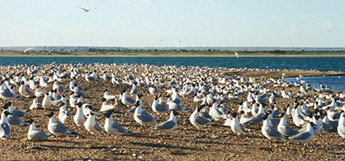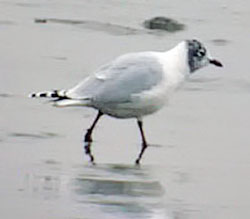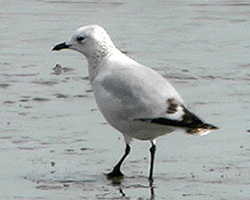
Distribution and Numbers

The Relict Gull Larus relictus is a globally rare and little-known species, breeding in Mongolia, Kazakhstan, parts of China and southern Russia (Birdlife 2003), and suspected of wintering mainly in the northern part of the Yellow Sea (Moores & Moores, 2002). Its total world population has been estimated recently at between 2 500 and 10 000 individuals and declining (Birdlife International, 2003). It is therefore classified as Vulnerable, threatened by increasing disturbance in breeding areas and by massive reclamation of intertidal areas in the Yellow Sea.
In South Korea, records of wintering birds range from between ca 6 and 185 individuals (with largest numbers coinciding with very cold winters, as in 2000/2001) and extreme dates falling between late November and early March, with stragglers into April. It is quite likely that fairly significant numbers are both underreported and still overlooked, especially as the species prefers the outer parts of tidal-flats and is not well-known by Korean birdwatchers.

Although claimed by Malling Olsen and Larsson (2003) to be wintering largely along the eastern coast of China into Viet Nam, there is very little supporting evidence for this. Rather, all the highest counts of the species have come from the northern part of the Yellow (or Bohai) Sea, either from "Happy Island" on the Hebei coast in autumn, or more recently from Tianjin Municipality, where there were 1,645 Relict Gull in March 2003 at the Tianjin Paleocoastal and Wetlands National Nature Reserve (Liu Yang et al, 2003), and 3,362 along a 6-km stretch of inter-tidal flats also in Tianjin municipality, on January 3rd, 2004 (Paul Holt in lit.), both areas with very extensive sand and sand-mud mix tidal flats.
Considering this distribution it is not all surprising that the highest numbers of Relict Gull in South Korea are recorded in severe winters, presumably when seas and tidal-flats are frozen further north. Birds along the east coast (including most of those wintering at the Nakdong estuary) are presumably those moving south from the Russian Maritimes or perhaps the Tumen Delta and the eastern coast of the DPRK.
Identification and Behavior
The Relict Gull is a reasonably easy species to identify if seen well due to its feeding behavior and structure, as well as its plumage and bare parts coloration. The species is found in four main age groups in Korea: First Winter (comprising the vast majority in mild winters); Second Winter; and Adult, either in non-breeding or breeding plumage (the latter from late February). The Relict Gull falls between Black-headed Larus ridibindus and Common GullLarus canus kamtschatschensis in size, but appears rather longer-necked, more pigeon-chested, and and perhaps proportionately shorter-legged with smallish feet, than either of these species.

Gangneung, April 2002, © Choi Soon-Kyoo.

plumage, Song Do, Incheon, February 2003.
© Nial Moores/Birds Korea.

© Charlie Moores/Birds Korea,
First Winters are most easily confused with Common Gull. However, unlike Common Gull they look almost white-headed, with a band of heavy streaking on the nape, an almost clean rather pale grey “saddle” (much paler than typical “Eastern" Common Gull”) contrasting with dark-centred tertials and a variably brown wash on the coverts of the closed wing. Diagnostically, the legs and bill appear black or blackish, and the eye-ring thick and heavy, giving birds a rather sleepy and “primitive” look.
Second Winters typically have reduced head and nape markings (often peppered with light grey flecks), show only weak dark markings in the tertials, and lack obvious white tips to the primaries of the closed wing.
Winter adults are perhaps more easily overlooked as Black-headed Gull, being largely white-headed with only variable grayish spotting on the nape, dark reddish legs and a bi-colored bill: deep red base and darker distal half. The structure and primary pattern is, however, typically distinctive showing quite prominent Saunders's Gull Larus saundersi-like white tips at rest, and a broad black wing-tip (closest to Common Gull) in flight.
Flying birds also have a distinctive shape, appearing rather “hump-backed” and small-headed.
Wintering birds appear to be superbly adapted to extreme weather conditions. A flock of 143 at Song Do, Incheon, in the very severe winter of 2000/2001, roosted on sea ice during the high-tide, waited as other birds started to feed in dense flocks on the first exposed tidal-flats, and only when extensive areas of tidal-flat were exposed and other species more spread out, did they all start to walk out from the roost, slowly fanning out towards the sea edge, picking at shellfish and other tidal-flat animals.

Unpublished South Korean counts Known to Birds Korea
The following are a list of counts made since 2000 which are not yet listed by Birdlife International (2003) in their online account, but which will be forwarded on to it by Birds Korea (Pre-2000 counts, including a peak of 65 in January 1991 (at the Nakdong estuary) are detailed at www.rdb.or.id/view_html.php?class=123&op=larureli.
We welcome any additional records or corrections:
| 2000 | |
| February 2 | 8, Suncheon Bay, Jeollanam Province (Nial Moores, Kim Kyung-Won) |
| February 10 | 8, all First-winters, Nakdong estuary, Busan (Nial Moores) |
| February 18 | 12 , Suncheon Bay, Jeollanam Province (11 First winters, one second-winter) (Nial Moores) |
| December 11 | ca 5, Jumunjin, Gangwon Province (Jon King, photographs in Malling Olsen and Larsson, 2003) |
| 2001 | |
| January 12 | 25, Nakdong estuary, Busan (Nial Moores and Kim Su-Kyung) |
| January 14 | 14, Suncheon Bay, Jeollanam Province (Nial Moores, Kim Su-Kyung) |
| January 20 | Two first winters, Posong Bay, Jeollanam Province (Nial Moores, Kim Su-Kyung) |
| Late-January | One, Asan Bay, Gyeonggi Bay (Nial Moores, Kim Su-Kyung) |
| February 3 | Peak count of 143 (at least 83 adults), Song Do, Incheon (Nial and Charlie Moores) |
| December 8 | Two, Song Do, Incheon (Nial Moores and Sunbird) |
| December 29 | Three, Nakdong estuary, Busan (Nial Moores) |
| 2002 | |
| January 7 | One second-winter, Nakdong estuary, Busan (Nial Moores, Kim Su-Kyung) |
| January 10 | One, Suncheon Bay, Jeollanam Province (Nial Moores, Kim Su-Kyung) |
| January 19 | One first-winter, Geum River estuary, Jeollabuk Province (Nial Moores, Kim Su-Kyung) |
| January 29 | Three, Song-Do, Incheon (Nial Moores) |
| February 6 | One First Winter and one Second Winter, Song Do, Incheon (Nial and Charlie Moores) |
| April 14 | Breeding plumaged adult, Gangneung, Gangwon Province (Choi Soon-Kyoo) |
| December 13 | 2 First winters, Pohang, Gyeongsanbuk Province (Andy Stoddart and Sunbird) |
| December 25 | 2 adults and 1 first winter, Nakdong Estuary (Sean Minns) |
| December 27 | 8, Nakdong estuary, Busan (Nial Moores) |
| December 31 | 10, Nakdong estuary, Busan (Nial Moores and Tim Allison) |
| 2003 | |
| January 10 | Three, Nakdong estuary, Busan (Nial Moores) |
| February 12 | 2, Nakdong estuary, Busan (Nial Moores) |
| February 14 | 14, Song Do, Incheon (13 adults), (Nial Moores and Bob Walton) |
| February 15 | 14, Song Do, Incheon (10 adults, one Second Winter, 2 First Winters, one un-aged) (Nial Moores and Bob Walton) |
| February 19 | Ten, Song Do, Incheon (Nial Moores, Gary and Marlene Babic) |
| March 17 | One First Winter, Nakdong estuary, Busan (Nial Moores) |
| April 27 | One First Winter, Geum estuary, Jeollabuk Province (Tim Allison) |
| November 23 | Three, Song Do, Incheon (Tim Edelsten) |
| December 28 | Four, Nakdong estuary, Busan (Nial Moores, Barry Heinrich) |
| December 28 | Two, Song Do, Incheon (Tim Edelsten) |
| 2004 | |
| January 9 | Two, Nakdong estuary, Busan (Nial Moores and Tim Edelsten) |
| January 13 | 3 (one adult, 2 First Winters) Nakdong estuary, Busan (Nial Moores, Peter and Erwin Collins) |
| February 8 | 3, Song Do, Incheon (Tim Edelsten) |
| February 24 | One First Winter, Nakdong estuary, Busan (Nial Moores) |
| March 18 | One First Winter, Nakdong estuary, Busan (Nial Moores) |
| March 28 | One First Winter, Gangwol Lake, Seosan, ChungCheongnam Province (Nial Moores, Ryan and Kara Lewantowicz) |
| October 30 | One first winter, Dongjin estuary, Saemangeum (Nial Moores and Peter Mann) |
| 2005 | |
| January 10 | Two, Nakdong estuary, Busan (Oliver Nieheus, Berit Ullrich) |
| January 12 | One First winter, Pohang, Gyeongsangbuk Province (Kim Sung-Hyun) |
| January 22 | One Second Winter, Song Do, Incheon (Nial Moores) |
| January 23 | One adult, Song Do, Incheon (Nial Moores, Gruff and Sara Dodd, Clive and Eleanor Hurley, Kingsley and Sharon Parker) |
| January 25 | Seven or eight, Song Do, Incheon (Mochizuki Kenji) |
References:
- Birdlife International (2003). Red Data Book Threatened Birds of Asia. Online version (at: www.rdb.or.id).
- Liu Y., Zhang Z-W, Zhang Y. & H-C Su. (2003). Record congregation of Relict Gull Larus relictus during the migration season. OBC Bulletin Number 38, December 2003.
- Malling Olsen, K & H. Larsson (2003). Gulls of Europe, Asia and North America. Published by Helm.
- Moores, N. & C. Moores (2002), Wetlands: Korea's most threatened habitat. Oriental Bird Club Bulletin 36, pp. 54-60.



